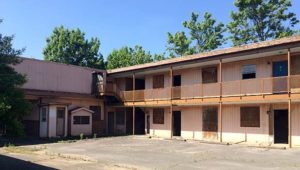In 1963, when the Rev. Martin Luther King Jr. was contemplating what to do with a judge’s injunction against marches, protests and assemblies of any sort, he consulted with other greats of the time at the A.G. Gaston Motel in Birmingham, Alabama. It was in room 30 that King, the Rev. Ralph Abernathy, the Rev. Fred Shuttlesworth and other civil rights movement leaders decided to march in defiance of the order and get arrested. King’s stint in jail resulted in his famous “Letter from a Birmingham Jail.”
The A.G. Gaston Motel is an important part of American history, but it is currently vacant and in disrepair. The building’s significance and condition are why it is on the 11 Most Endangered Historic Spaces List. The National Trust for Historic Preservation releases the annual list in hopes of preserving architectural and cultural treasures that are vulnerable to demolition or neglect.
“As a gathering place for prominent leaders in the civil rights movement, the A.G. Gaston Motel stood at the center of one of the most significant events in our nation’s history. We hope that adding the Gaston Motel to our list of 11 Most Endangered Historic Places, helps raise awareness about this important place and focuses attention on the urgent need to restore it. A proper reuse of the Gaston will allow it to become a living library that teaches future generations about the powerful events that occurred there,” said Stephanie Meeks, president of the National Trust for Historic Preservation.
In the case of the A.G. Gaston Motel, its cultural significance is what has the modest two-story building on the list. In addition to housing King’s “war room,” the motel also has historic relevance because of its original owner.
Arthur George (A.G.) Gaston was a Black, self-made millionaire who earned his fortune from various business ventures in insurance, banking and funeral homes. Born on the Fourth of July in 1892, the grandson of former slaves, Gaston blazed an entrepreneurial path that resulted in him eventually building the A.G. Gaston Motel in 1954 in a still-segregated Birmingham. Located just steps from the 16th Street Baptist Church — site of the 1963 bombing that killed four Black girls — it suffered a bombing of its own in that same year. Gaston, who paid $150,000 (in today’s dollars) to bail King out of jail, died at the age of 103 with a fortune that was reportedly over $100 million.
The motel’s numerous historical attributes have not, however, been able to protect it from the ravages of time. The A.G. Gaston Motel is now vacant, in need of repair and city-owned. During a Google-Hangout session with the National Trust for Historic Preservation, the mayor of Birmingham reiterated his commitment to saving the motel and using it as a civil rights center.
“We want to create a center here as part of the revitalization of the A.G. Gaston Motel that we could invite people from around the world to come and discuss their differences and come talk about the positive things they can do to make this a better world, said Mayor William Bell.
Though the motel is steeped in history, Bell has his eye on the future and wants to make sure young people are involved so that the legacy and culture are preserved. “I have set meetings with young people all across the city to talk about the future of this great city and to seek their advice and counsel. Part of the center will be for students so they can come and learn about civil rights history, but also to develop negotiation skills,” noted Bell. “Because of things in the news now about the police and community relationship and the Black Lives Matter movement, what can we learn from our history that can assist us in the present course of events? How can we change things through nonviolent methods for the better? That requires involving young people. My knees and legs are too old to be out there doing the things I used to do in my youth. The energy level and commitment required to do this work. So, yes we have to involve the young people so that they know that they have a civic responsibility as well as a social responsibility.”
Descriptions of all 11 sites on this year’s Most Endangered Historic Places List can be found at the National Trust for Historic Preservation website.



